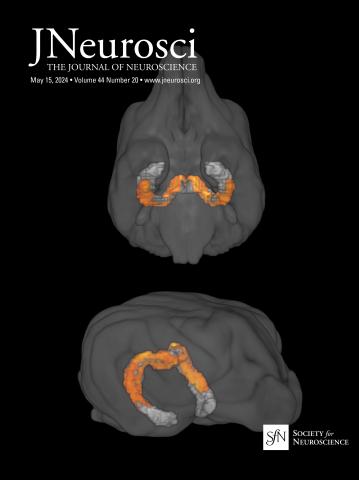Microglia supports both the singular form of LTP expressed by the lateral perforant path and episodic memory.
IF 4.4
2区 医学
Q1 NEUROSCIENCES
引用次数: 0
Abstract
We report here that microglia exert a surprisingly discrete but functionally critical influence on synaptic plasticity in mouse hippocampus. Treatment of adult male mice with colony stimulating factor 1 receptor antagonist PLX5622 (PLX), with resultant depletion of forebrain microglia, did not disturb basal synaptic transmission at four synaptic connections in hippocampus. Long-term potentiation (LTP) was also intact for three of these sites, but the singular, endocannabinoid-dependent form of LTP expressed by lateral perforant path (LPP) input to the dentate gyrus (DG) was severely impaired. The LPP-LTP defect occurred in conjunction with a pronounced increase in DG (but not neocortical) levels of 2-arachidonoylglycerol (2-AG), the retrograde (spine-to-terminal) endocannabinoid messenger that initiates LPP-LTP. Despite this, concentrations of the 2-AG synthetic enzyme diacylglycerol lipase were not affected by PLX treatment. Synaptic levels of the cannabinoid type 1 receptor, which mediates 2-AG effects on LPP-LTP, were similarly unaffected. Prior work has implicated the LPP in episodic memory. We determined that the LPP-LTP impairment in PLX-treated mice was accompanied by a failure to acquire the three basic elements of an episode: the identities, locations, and presentation order for a collection of olfactory cues. Treatment with JZL184, which inhibits the 2-AG degradative enzyme monoglyceride lipase, restored both LPP-LTP and episodic 'What' encoding in PLX-treated mice. We conclude that microglia selectively regulate endocannabinoid transmission at the LPP-DG synapse and thereby potently influence synaptic plasticity at the initial stage of a cortico-hippocampal circuit that is critical for episodic memory.Significance Statement There has been considerable interest in microglial involvement in the moment-to-moment operations of the brain. However, the present studies show that, with one prominent exception, treatments that significantly deplete forebrain microglia have no detectable influence on synaptic operations at multiple sites within hippocampus. Nevertheless, long-term potentiation was selectively disrupted within the lateral perforant path, a primary cortical input to hippocampus. Relatedly, microglial depletion was associated with severe impairments in encoding the principal components of episodic memory. These results indicate microglial influences on synaptic transmission are surprising discrete and yet essential for orderly cognition.小胶质细胞既支持外侧穿孔通路表达的LTP的单一形式,也支持情景记忆。
我们在此报道,小胶质细胞对小鼠海马突触可塑性的影响出人意料地离散,但在功能上至关重要。用集落刺激因子1受体拮抗剂PLX5622 (PLX)治疗成年雄性小鼠,导致前脑小胶质细胞耗竭,但不会干扰海马四个突触连接的基础突触传递。其中三个位点的长期增强(LTP)也完好无损,但通过侧穿通道(LPP)输入齿状回(DG)表达的单一的内源性大麻素依赖形式的LTP严重受损。LPP-LTP缺陷与DG(但不是新皮质)2-花生四烯醇甘油(2-AG)水平的显著增加同时发生,2-AG是启动LPP-LTP的逆行(脊柱到末端)内源性大麻素信使。尽管如此,2-AG合成酶二酰基甘油脂肪酶的浓度不受PLX处理的影响。介导2-AG对LPP-LTP影响的大麻素1型受体的突触水平同样不受影响。先前的研究表明LPP与情景记忆有关。我们确定,plx治疗小鼠的LPP-LTP损伤伴随着无法获得事件的三个基本要素:嗅觉线索集合的身份、位置和呈现顺序。JZL184抑制2-AG降解酶单甘油酯脂肪酶,在plx治疗的小鼠中恢复了LPP-LTP和偶发性“What”编码。我们得出结论,小胶质细胞选择性地调节LPP-DG突触的内源性大麻素传递,从而潜在地影响皮质-海马回路初始阶段的突触可塑性,这对情景记忆至关重要。对于小胶质细胞参与大脑的实时操作,人们已经有了相当大的兴趣。然而,目前的研究表明,除了一个突出的例外,显著消耗前脑小胶质细胞的治疗对海马内多个部位的突触操作没有可检测到的影响。然而,长期增强在外侧穿孔通路中被选择性地破坏,外侧穿孔通路是海马的主要皮层输入。与此相关的是,小胶质细胞耗竭与情景记忆主要成分编码的严重损伤有关。这些结果表明,小胶质细胞对突触传递的影响是令人惊讶的离散的,但对有序认知是必不可少的。
本文章由计算机程序翻译,如有差异,请以英文原文为准。
求助全文
约1分钟内获得全文
求助全文
来源期刊

Journal of Neuroscience
医学-神经科学
CiteScore
9.30
自引率
3.80%
发文量
1164
审稿时长
12 months
期刊介绍:
JNeurosci (ISSN 0270-6474) is an official journal of the Society for Neuroscience. It is published weekly by the Society, fifty weeks a year, one volume a year. JNeurosci publishes papers on a broad range of topics of general interest to those working on the nervous system. Authors now have an Open Choice option for their published articles
 求助内容:
求助内容: 应助结果提醒方式:
应助结果提醒方式:


